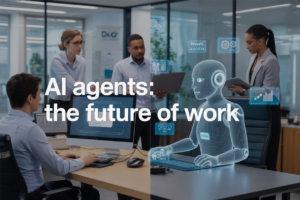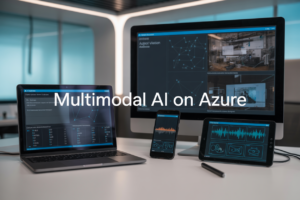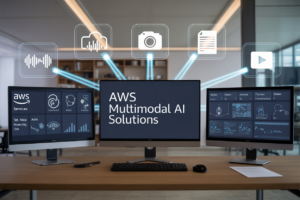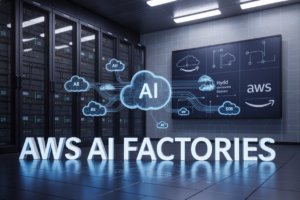Have you ever wondered how modern tech giants handle millions of real-time events seamlessly? 🤔 The secret lies in Event-Driven Architecture (EDA), a powerful approach that’s revolutionizing the way we build and scale digital systems. From Netflix’s content recommendations to Uber’s ride-matching algorithm, EDA is the backbone of countless applications we use daily.
But what exactly is Event-Driven Architecture, and why is it causing such a buzz in the tech world? 🐝 Imagine a system that can instantly react to changes, process vast amounts of data in real-time, and scale effortlessly. That’s the power of EDA, and it’s transforming how businesses operate in our fast-paced digital landscape. In this blog post, we’ll dive deep into the world of Event-Driven Architecture, exploring its key components like Kafka and microservices, and uncovering how it enables the creation of robust real-time systems.
Get ready to embark on a journey through the intricacies of Event-Driven Architecture. We’ll start by unraveling the core concepts, then explore how Kafka powers real-time data streams, delve into the role of microservices, and finally, discover best practices for implementing EDA in your own projects. Whether you’re a seasoned developer or a curious tech enthusiast, this guide will equip you with the knowledge to harness the full potential of Event-Driven Architecture. Let’s dive in! 🏊♂️
Understanding Event-Driven Architecture
Key components of EDA
Event-driven architecture (EDA) consists of several crucial components that work together to create a responsive and scalable system:
- Event producers
- Event consumers
- Event channels
- Event processors
Let’s explore these components in more detail:
| Component | Description | Example |
|---|---|---|
| Event producers | Generate events based on state changes or actions | User clicking a button, sensor detecting temperature change |
| Event consumers | React to events and perform specific actions | Updating a database, sending notifications |
| Event channels | Facilitate event transmission between producers and consumers | Message queues, event buses |
| Event processors | Transform, filter, or aggregate events | Combining multiple events, enriching event data |
Benefits for modern software systems
Event-driven architecture offers numerous advantages for modern software systems:
- Scalability: EDA allows for easy scaling of individual components
- Flexibility: New features can be added without disrupting existing functionality
- Real-time responsiveness: Events are processed as they occur
- Loose coupling: Components are decoupled, reducing dependencies
- Improved fault tolerance: System can continue functioning even if some components fail
Comparison with traditional architectures
When comparing EDA to traditional architectures, several key differences emerge:
| Aspect | Event-Driven Architecture | Traditional Architecture |
|---|---|---|
| Communication | Asynchronous, event-based | Synchronous, request-response |
| Coupling | Loose coupling between components | Tight coupling between components |
| Scalability | Highly scalable | Limited scalability |
| Flexibility | Easily adaptable to changes | More rigid and difficult to modify |
| Data flow | Push-based | Pull-based |
Now that we have a solid understanding of event-driven architecture, let’s explore how Kafka plays a crucial role in powering real-time data streams within this paradigm.
Kafka: Powering Real-Time Data Streams
Core concepts of Apache Kafka
Apache Kafka is a distributed streaming platform that serves as the backbone for many event-driven architectures. At its core, Kafka operates on a publish-subscribe model, where data is organized into topics. Producers write data to topics, while consumers read from them.
Key concepts in Kafka include:
- Topics: Logical channels for data streams
- Partitions: Subdivisions of topics for parallel processing
- Brokers: Servers that store and manage data
- Zookeeper: Coordinates the Kafka cluster
| Concept | Description |
|---|---|
| Topics | Named feeds or categories of messages |
| Partitions | Ordered, immutable sequence of records |
| Brokers | Kafka servers that store and serve data |
| Zookeeper | Manages cluster state and configuration |
Scalability and fault-tolerance features
Kafka’s architecture is designed for high scalability and fault tolerance. It achieves this through:
- Distributed nature: Multiple brokers work together
- Replication: Data is copied across brokers for redundancy
- Partitioning: Allows parallel processing and load balancing
These features enable Kafka to handle massive amounts of data in real-time, making it ideal for event-driven systems.
Use cases in event-driven systems
Kafka finds application in various event-driven scenarios:
- Real-time analytics
- Log aggregation
- Stream processing
- Event sourcing
- Microservices communication
Integration with other technologies
Kafka’s versatility allows it to integrate seamlessly with:
- Stream processing frameworks (e.g., Apache Flink, Spark Streaming)
- Big data technologies (e.g., Hadoop, Hive)
- Microservices frameworks (e.g., Spring Boot, Quarkus)
This integration capability makes Kafka a central component in modern data architectures. As we move forward, we’ll explore how microservices leverage Kafka in event-driven systems.
Microservices in Event-Driven Systems
Decoupling services through events
Event-driven architecture (EDA) plays a crucial role in decoupling microservices, allowing them to operate independently while maintaining communication. By using events as the primary means of interaction, services can remain loosely coupled, promoting flexibility and scalability.
- Benefits of event-driven decoupling:
- Reduced dependencies between services
- Improved fault isolation
- Easier maintenance and updates
- Enhanced system modularity
Improving system resilience and scalability
EDA significantly enhances the resilience and scalability of microservices-based systems. By leveraging event streams, services can scale independently based on their specific needs, leading to more efficient resource utilization.
| Aspect | Traditional Architecture | Event-Driven Architecture |
|---|---|---|
| Scalability | Limited by tight coupling | Highly scalable due to loose coupling |
| Resilience | Single point of failure risks | Improved fault tolerance |
| Performance | Potential bottlenecks | Better load distribution |
Challenges and best practices
While EDA offers numerous advantages, it also presents unique challenges:
- Event versioning and compatibility
- Ensuring data consistency across services
- Handling event ordering and idempotency
- Managing event schema evolution
Best practices to address these challenges include:
- Implementing event versioning strategies
- Using event schemas and contracts
- Designing for eventual consistency
- Implementing idempotent event handlers
Event sourcing and CQRS patterns
Event Sourcing and Command Query Responsibility Segregation (CQRS) are powerful patterns often used in event-driven microservices architectures.
Event Sourcing:
- Stores state changes as a sequence of events
- Enables precise auditing and temporal queries
- Facilitates event replay for system recovery
CQRS:
- Separates read and write operations
- Optimizes query and command models independently
- Enhances scalability and performance
By combining these patterns with EDA, organizations can build highly scalable, resilient, and maintainable microservices-based systems.
Building Real-Time Systems with EDA
Designing event-driven workflows
When building real-time systems with Event-Driven Architecture (EDA), designing effective event-driven workflows is crucial. Start by identifying key events and their corresponding handlers. Create a flowchart to visualize the event flow and system interactions.
Event identification and mapping
- Business events (e.g., order placed, payment received)
- System events (e.g., data updates, error occurrences)
- User-triggered events (e.g., button clicks, form submissions)
| Event Type | Example | Handler |
|---|---|---|
| Business | Order placed | Inventory update |
| System | Database error | Error logging |
| User | Login attempt | Authentication check |
Handling high-volume data streams
To manage high-volume data streams effectively, implement:
- Parallel processing
- Load balancing
- Data partitioning
- Caching mechanisms
Use stream processing frameworks like Apache Flink or Spark Streaming to handle real-time data analysis and processing at scale.
Ensuring data consistency and reliability
Maintaining data consistency in distributed systems is challenging. Implement:
- Event sourcing: Store all changes as a sequence of events
- CQRS (Command Query Responsibility Segregation): Separate read and write operations
- Idempotent event handlers: Ensure multiple processing of the same event doesn’t cause issues
- Exactly-once delivery semantics: Guarantee events are processed only once
Monitoring and debugging event-driven systems
Effective monitoring is essential for maintaining real-time systems. Implement:
- Distributed tracing
- Log aggregation
- Real-time dashboards
- Alerting systems
Use tools like Prometheus, Grafana, or ELK stack for comprehensive system monitoring and debugging.
Now that we’ve covered building real-time systems with EDA, let’s explore best practices and patterns for implementing Event-Driven Architecture effectively.
Implementing EDA: Best Practices and Patterns
Choosing the right event schema
When implementing Event-Driven Architecture (EDA), selecting an appropriate event schema is crucial for system efficiency and scalability. Consider the following factors:
- Data consistency
- Compatibility across services
- Flexibility for future changes
- Performance impact
Here’s a comparison of popular event schema formats:
| Schema Format | Pros | Cons |
|---|---|---|
| JSON | Readable, widely supported | Larger payload size |
| Avro | Compact, schema evolution | Requires schema registry |
| Protocol Buffers | Efficient serialization | Language-specific tooling |
Managing event versioning
Effective version management ensures smooth system evolution. Implement these strategies:
- Use semantic versioning for events
- Maintain backward compatibility
- Employ schema registries for version control
Handling failure scenarios
Robust error handling is essential in EDA. Implement:
- Dead letter queues for unprocessable events
- Retry mechanisms with exponential backoff
- Circuit breakers to prevent cascading failures
Scaling event-driven architectures
To scale your EDA effectively:
- Implement horizontal scaling of consumers
- Use partitioning for parallel processing
- Optimize event store performance
- Consider event sourcing for complex domains
Security considerations in EDA
Ensure your EDA implementation addresses these security aspects:
- Encrypt sensitive data in events
- Implement strong authentication and authorization
- Use secure communication protocols (e.g., TLS)
- Regularly audit event access and processing
By following these best practices and patterns, you’ll create a robust, scalable, and secure event-driven architecture. Next, we’ll explore real-world case studies of successful EDA implementations across various industries.
Event-Driven Architecture (EDA) offers a powerful paradigm for building scalable, responsive, and real-time systems. By leveraging technologies like Kafka and implementing microservices, organizations can create robust architectures that efficiently handle complex data streams and deliver immediate value to users. The decoupled nature of EDA allows for greater flexibility and easier maintenance, making it an attractive option for modern software development.
As businesses continue to prioritize real-time data processing and instant responsiveness, adopting EDA becomes increasingly crucial. By following best practices and established patterns, developers can harness the full potential of event-driven systems, enabling their organizations to stay competitive in a rapidly evolving digital landscape. Embrace EDA to unlock new possibilities in your software architecture and drive innovation in your industry.




















